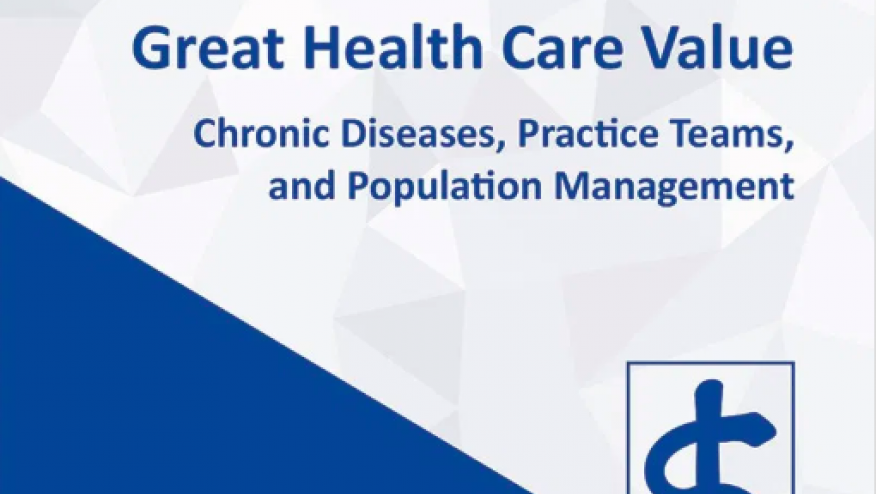Book Review: “Great Health Care Value: Chronic Diseases, Practice Teams and Population Management” Save

We all agree that the US healthcare market has evolved into an incredibly expensive system that often does not deliver good medical outcomes. We clearly spend more than any other nation and our outcomes are often quite inferior to other western nations. There is tremendous profiteering by the insurance industry, the pharmaceutical industry, some hospital administrations, medical device industry and probably the legal profession.
While most of us know these problems exist, we rarely have up-to-date data or offer alternatives to the way we manage care, especially to the chronically ill who consume much of our health care dollars.
Authors Tim Harrington, MD and Andrew Johnson, MS, MBA offer insights into some of the important issues, and evidence and experience on how we may do our part to improve the management of chronic rheumatic/orthopedic issues.
Tim is a rheumatologist with an academic and clinical career. He wrote a previous book with another rheumatologist, Eric Newman, entitled “Great Health Care: Make it Happen” which was referenced several times in his new book. While it is called a book, it really resembles the old “Primer on Rheumatic Diseases” when it was less than an inch in thickness (informative, concise and readable while on the one-month rheumatology rotation). Of course, the latest versions of the rheumatology primer and the primer on metabolic bone diseases used by my residents resemble huge textbooks that rapidly get outdated and are too big to carry in your backpack!
One key theme of this book is to emphasize the concept of high value rather than just maximizing revenue, which has been the primary motivator in American health systems for many years. They spend time defining value and distinguishing it from quality. This is very important in chronic conditions like rheumatoid arthritis and in my world of osteoporosis. We have great treatments for these conditions and we can improve value but most of us are locked in the classic fee for service, one patient at a time, income or RVU generation factories that may impact individual patients but probably come up short for what we could do for the American health system.
The authors describe their experience with a project known as RAPP (Rheumatoid Arthritis Performance Project). I will admit I saw some posters and maybe read an abstract, but I did not take a deep dive into the RAPP experience when it was published. Some of the insights they learned are very helpful if we want to improve value in the management of the chronic diseases that are described in our textbooks. I was especially interested in their observations about different types of clinicians and how they did or did not utilize some of the pathways to assist management of RA. The solo rheumatologists were the best at adopting the change in practice. Single specialty groups were pretty good unless one or two partners were “non-adopters”. Employed physicians in large hospital based multi-specialty organizations struggled the most to get institutional buy-in, and often did not become “adopters”. This might be a good section to have your fellows read as they make their important first job choices.
I found their section on the use of advanced practice providers (ANP, PA, nurses) in chronic disease management quite useful. We all agree there is a shortage of good clinicians to manage rheumatic disease and osteoporosis. It is not as easy as the VP at the hospital thinks to just hire a part-time ANP to do rheumatology or osteoporosis management. Most of us were not all that prepared to do a good job with many of our diseases right out of fellowship. Grey hair (or going bald) often is accompanied by medical wisdom and seeing rare conditions once puts the clinician one step ahead of the neophyte. To think that you can have a PA with 2-3 years of training or a nurse with 2 years of clinical experience jump right in and be an effective clinician for chronic diseases is a fallacy. Tim has some nice guidance of how nurses and PA/ANP might be better utilized to improve access to good care and even be financially viable. Years ago, I helped the ACR/AARP develop an online curriculum for PA/ANPs who were interested in becoming rheumatology clinicians with an MD. These educational programs are crucial to have trained professionals that can deliver medical value.
We should all engage to some level in the discussion of our profession in the US and how it can be improved. The ACP has recently supported major reform with the option of a single health care system run by the government. I think we are headed there someday. I have had the opportunity to work all over the world in my days in pharma. The US lags far behind most western nations in delivering value to the population. If you are wealthy in Scottsdale, AZ you can get great care at places like Mayo. If you are blue collar with marginal benefits you may go bankrupt with a serious illness. We need to be informed if we want to rescue our “profession”. We need to work with students, residents and fellows and make sure they understand this is a “profession” and not just a job.
Unfortunately, the management of our profession has gone to non-physicians or physicians who have their MBAs and do not often resemble most practicing physicians. I would encourage you to read this book to at least get more facts about the state of our national health care. It is pretty ill, and we need to have an informed voice to share with our patients, families and maybe even congressmen if we wish to see improvement of our profession.










If you are a health practitioner, you may Login/Register to comment.
Due to the nature of these comment forums, only health practitioners are allowed to comment at this time.